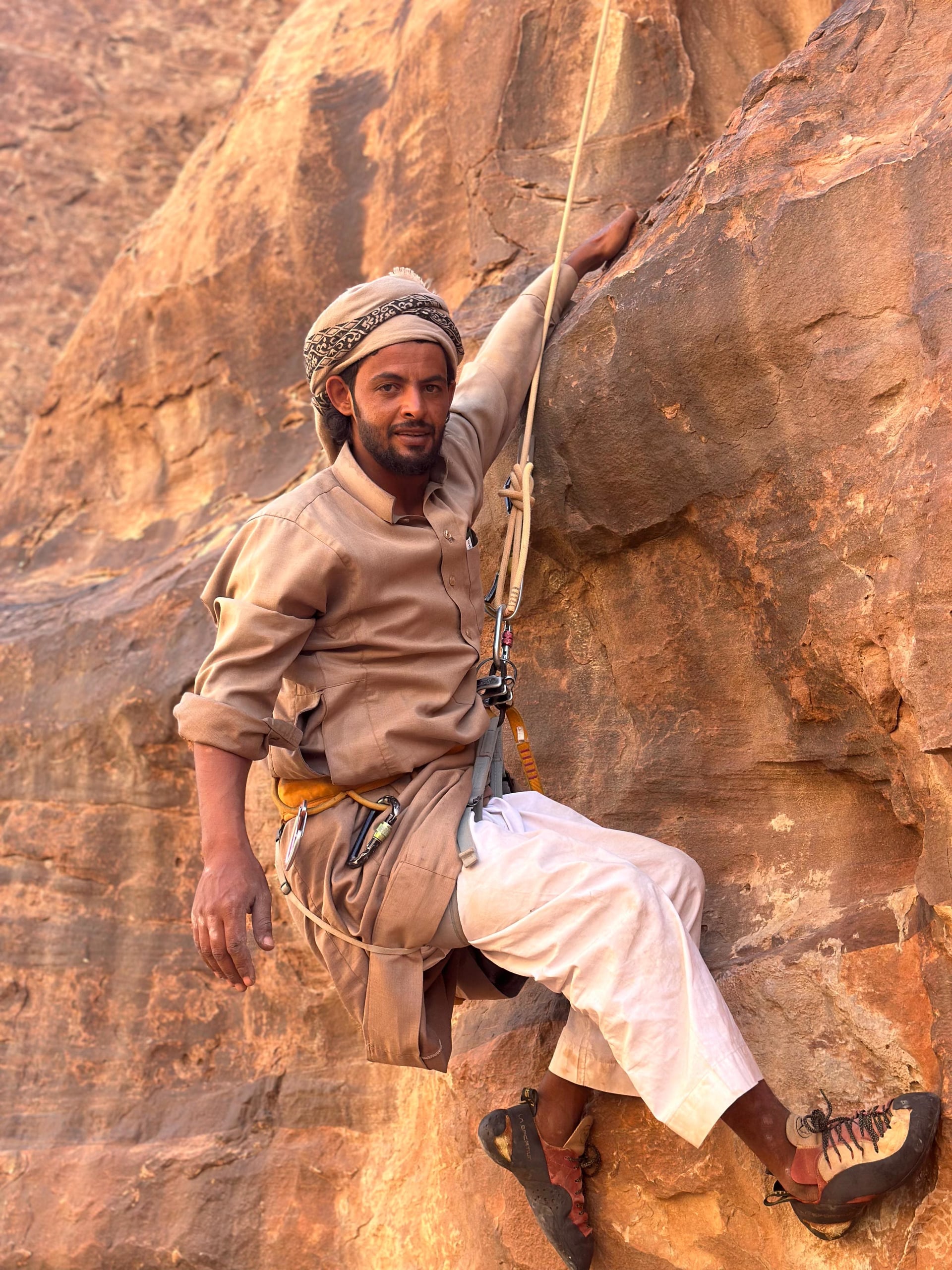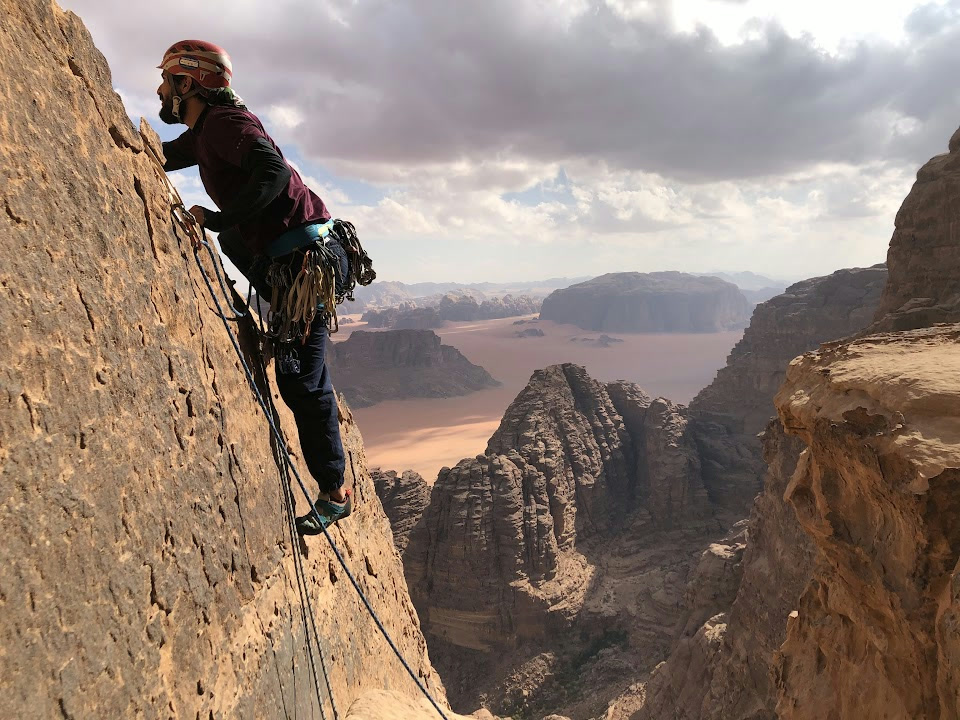Wadi Rum's sandstone is unlike any rock you've climbed before. Sculpted by millions of years of wind and water, it presents unique challenges and rewards. Understanding this rock is key to climbing safely and enjoyably in the desert.
Reading the Rock by Color
In Wadi Rum, color tells you everything about rock quality. My grandfather taught me to read the stone before touching it, and this knowledge has kept me safe for years.
Dark Red and Black
Best Quality: Dark red (copper-colored) and black sandstone is generally the most solid. These areas have been hardened by mineral deposits and water action over millennia. You'll find excellent holds, solid protection placements, and reliable rock. This is where we prefer to climb.
Light Red and Orange
Good Quality: The classic Wadi Rum color. This rock is generally solid but requires more care. Test holds before committing full weight. Look for areas where water has polished the surface-these are usually very solid.
Yellow and Pink
Caution Required: Lighter colors often indicate softer, more sandy rock. These areas can be fragile, with holds that may break. We approach these sections carefully, testing everything and using multiple points of contact.
White
Variable: White rock can be either very hard (like the summit domes) or very soft. The white summit domes of Jebel Rum are actually quite solid, but white streaks on faces can be soft and crumbly.
"The colors, changing with different lighting throughout the day, vary from black to red, passing through purple and white! These often indicate the character of the rock. A wise observation, with a bit of experience, can determine its quality."
- Wilfried Colonna, from Tony Howard's guidebook
Unique Rock Features
Tafoni (Honeycomb Weathering)
These are the distinctive honeycomb patterns you see everywhere in Wadi Rum. Created by salt crystallization and wind erosion, tafoni provide excellent handholds and footholds. The edges are usually solid, but always test the depth-some pockets are shallow, others go deep into the rock.
Horizontal Stratification
Wadi Rum's sandstone was laid down in horizontal layers millions of years ago. This creates natural ledges and "promenade terraces" that make route-finding possible. It also creates overhanging bulges where harder layers protrude. Understanding this layering helps you predict where you'll find rests and difficulties.
Water-Polished Surfaces
Where water flows (in chimneys and gullies), the rock is often polished smooth and extremely solid. These sections can be slippery but offer some of the most unique climbing in Wadi Rum. Good friction technique is essential here.
Mickey Mouse Ears
These distinctive rounded protrusions look like cartoon ears and are found throughout Wadi Rum. They make excellent handholds and are usually quite solid. They're formed by differential erosion where harder nodules resist weathering.
Climbing Techniques for Sandstone
1. Test Everything
Unlike granite, sandstone holds can break. Always test holds before committing your full weight. Tap them, pull gently, then harder. If you hear a hollow sound or feel movement, find another hold.
2. Use Your Feet
Sandstone offers excellent friction. Trust your feet on slabs and use smearing techniques. The rock is abrasive-it will grip your shoes well but will also wear them out faster than other rock types.
3. Multiple Points of Contact
Distribute your weight across multiple holds rather than loading one heavily. This is especially important on softer rock. Think of it like walking on sand-spread your weight.
4. Chimney Techniques
Many routes follow chimney systems. Learn to use opposing pressure between walls. Back-and-foot, stemming, and bridging techniques are essential. The rough sandstone provides excellent friction for these techniques.
5. Route Finding
Unlike sport climbing with bolted lines, Wadi Rum requires constant route-finding. Look for natural lines of weakness, follow color changes to better rock, and watch for cairns marking traditional paths. Sometimes the easiest way is not the most obvious.
Protection Considerations
Natural Protection
The chaotic surface of Wadi Rum sandstone provides excellent opportunities for natural protection:
- • Cams/Friends: Work well in solid cracks and pockets
- • Nuts: Good in constrictions, but test placements carefully
- • Slings: Thread around solid features, horns, and through tunnels
Fixed Protection
Traditional pitons don't hold well in sandstone. When fixed protection is necessary, we use expansion bolts, but these must be placed carefully in solid rock. Always back up fixed protection with natural gear when possible.
Learn from a Local Expert
Understanding Wadi Rum's sandstone takes experience. When you climb with me, I'll teach you to read the rock, choose the best holds, and place protection safely. This knowledge will make you a better, safer climber in any sandstone environment.
Book a Guided ClimbThe Abrasive Nature
One thing every climber notices: Wadi Rum sandstone is "sournoisement abrasif" (sneakily abrasive), as the French climbers say. It will:
- • Wear through climbing shoes faster than granite
- • Abrade ropes if they rub against edges
- • Roughen your hands (bring tape and hand cream!)
- • But also provide excellent friction for feet and hands
Weather Effects
After Rain: The rock becomes more solid when wet but also more slippery. Water channels can become dangerous with flash floods. We avoid climbing immediately after rain.
Temperature: Extreme heat can make the rock uncomfortably hot to touch. We climb early morning or late afternoon in summer. Cold weather makes the rock more brittle.
Understanding Wadi Rum's sandstone transforms it from intimidating to inviting. What first seems loose and dangerous becomes a playground of features and possibilities. This is the rock my ancestors climbed for generations, and with knowledge and respect, it offers some of the most unique climbing in the world.
Technical information and quotes sourced from "Treks and Climbs in Wadi Rum, Jordan" by Tony Howard, used with permission.


💬 Join the Discussion
Share your thoughts, experiences, or questions about this article